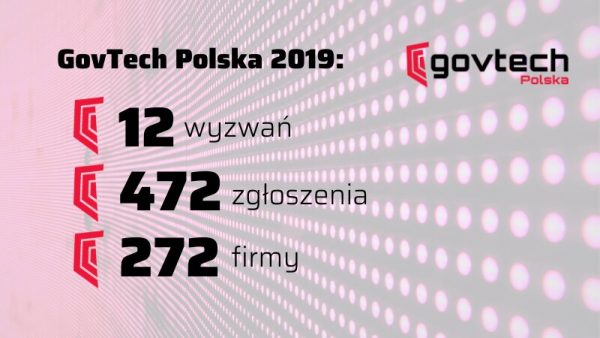Combining business requirements and technology can sometimes be like a cruise in a sailboat across a rough ocean with a crew, which half wants to go left and the other half wants to go right. Our implementation of the concept for the Govtech competition looked similar. Where and with what result did we get there?
GovTech challenges
At inProjects, we regularly operate at the crossroads of business and technology, because the projects that we implement as a project house require us to combine competences from various areas (we wrote about it, e.g. here). Despite our experience in this matter, it is still a challenge for us to reconcile business requirements and technological solutions. Recently, this kind of challenge was creating the winning concept in the GovTech competition.
For GovTech competition we were preparing the concept of the Platform presenting the investment attractiveness in areas of white spots in Internet access. GovTech contests are a new way of selecting technological solutions for challenges faced by public institutions and state-owned enterprises. The competition formula gives a chance to submit their ideas to smaller companies that would not take part in the traditional tender process. The GovTech competition has a less official form than public proceedings, which increases the chance for an innovative and efficient approach to solving a given problem.
The Office of Electronic Communications stated one of the challenges. It was the creation of the concept of a platform showing whether a selected area of the country is an attractive investment for Internet providers that can build fibre-optic infrastructure in a given area. While it is simple to indicate on the map places where access to the Internet is difficult, determining whether building a telecommunications network in such an area is a profitable investment is a very complex issue.

Investment attractiveness, indicators and algorithms
At the first stage of the competition, it was necessary to create indicators and algorithms that are calculating them, which, based on the available data, will determine the investment attractiveness of a given area. At the second stage, it was necessary to calculate the investment attractiveness for 5 areas selected by the Office of Electronic Communications using the proposed indicators and algorithms and to present a detailed description of the platform’s IT system.
The Office of Electronic Communications’ challenge is an excellent example of technology productisation. On the one hand, we need a scalable IT system based on the advanced algorithms, and on the other, we have a specific business need that will be satisfied only through a clearly and simply presented analysis result, in other words, business intelligence in its purest form.
Two perspectives
Creation of the concept required the involvement of network design specialists and programmers in the process. The first ones had a piece of expert knowledge to determine what, for a telecommunications operator (investor), is essential to define the attractiveness of a given area in the context of building a fibre-optic network, meanwhile the latter ones know how to create algorithms and a system presenting results. So we have everything… Now we merely need to combine these two perspectives.
We can safely say that the combination of competences did not go too badly for us. We won both stages of the competition and were selected by the Office of Electronic Communications to create a platform based on our concept. However, this does not mean that the process of its formation was a cruise on an uninterrupted ocean. Our journey featured sunny, windless days on clean water, but also unforeseen, strong gusts of wind that swayed us, and even a small storm. As a project house, we have faced similar challenges more than once, so we will share with you what happened in our process and what we would do better next time.

A good start will give you an advantage
In many different kinds of sports it is difficult to achieve a good result at the finish line without a good start. The same is with every project that needs to be carried out by people with different specialisations. Take care of the appropriate kickoff, i.e. a meeting where everyone will get to know each other will find a common understanding of the project and will set the rules of cooperation. Think about what may generate conflicts or misunderstandings in the course of the project, where problems may arise, and collectively prepare solutions that you will then use, e.g. you will limit communication on messengers in favour of short teleconferences or stand-up meetings.
All from one place
Speaking of a good start, all participants must start from the same stage. We didn’t do it. We decided to implement senior developers in the concept development process only at the stage of describing the system and the previously formed indicators. It was not the best move. The programmers’ working time, apparently saved in the first stage, had to be used later to introduce them to what the network designers had developed. Our advice? Keep everyone in the information loop, e.g. through short status meetings.
Know your enemy – understand the problem, learn about resources
It is challenging to look for solutions together if you do not know the source of the problem and the resources that can help you solve it. Before starting the operation, it is worth investing time in better understanding the specifics of the work of everyone involved in the project. Developers who even have an elementary insight into the telecommunications network design process can propose better solutions, and designers who know a bit about software development will understand that sometimes something seemingly simple requires complex tools.

Words like keys
Since all interested parties already know what their responsibilities are and they speak a little more understandable language, a common dictionary may also come in useful and the certainty that a yes means a yes and a no is a no. The collective meaning will be vital in the case of any abbreviations or concepts specific to each industry. We wish we had done it at the beginning of the project. It would certainly spare us some passionate discussions.
Is there an interpreter on board?
Despite the sincere willingness and effort, effective communication between representatives of business and technology is not always successful. Then the presence of an interpreter, i.e. a person with knowledge and experience in both business and technical issues, turns out to be invaluable. Fortunately, our team consists of a person who successfully finds a mutual ground between what needs to be done and how to do it. Although it may seem that it is someone in the team who does not work and instead only talks, it would be challenging without this talking. Trust us, we know from experience…

Silence is not always golden
A team composed of people with different competencies is an excellent value for the project and the company. However, it must be remembered that Stan Lee was right while saying “With great power comes great responsibility”. It’s easy to deliver a sophisticated system with a set of great features that doesn’t solve any problem. We tried very hard to avoid this during the creation of the competition concept and, in our opinion, it resulted in the possibility of implementing the project. The tips we’ve outlined above, we can conclude into the one sentence: Communication is the key. Talking, questioning, determining, investigating is necessary to find common ground between business and technology, and this is necessary to create a valuable product. Now, during the development of the Platform, we also do not run away from meetings and we do not shorten the time we spend talking about the project. And we recommend it to you as well, do not be afraid of the time spent on talking. Provided you are talking on the subject 😉
We would love to talk about transforming your idea into a product, so please contact us by email info@inprojects.pl so we can propose solutions that fits your needs best.